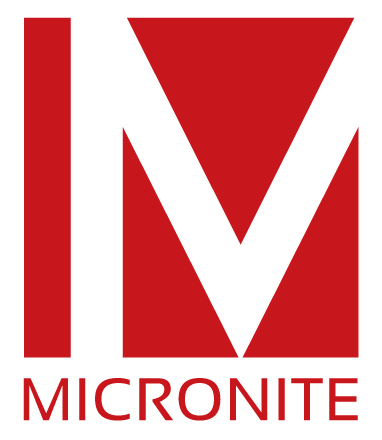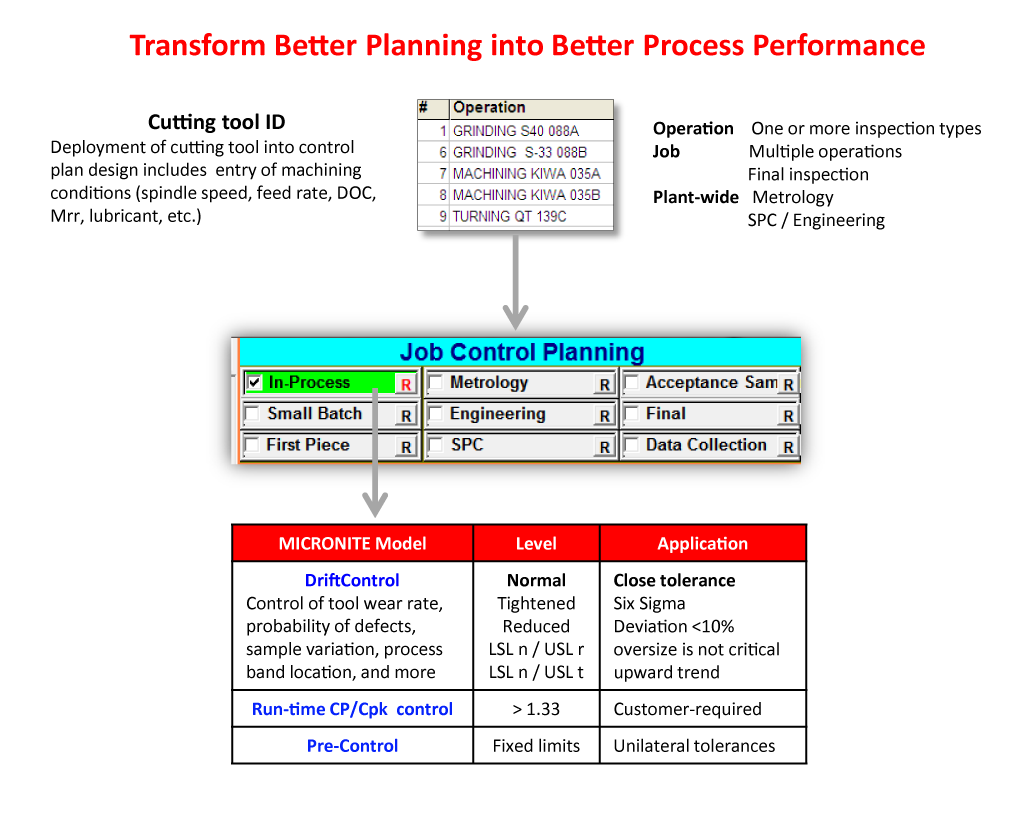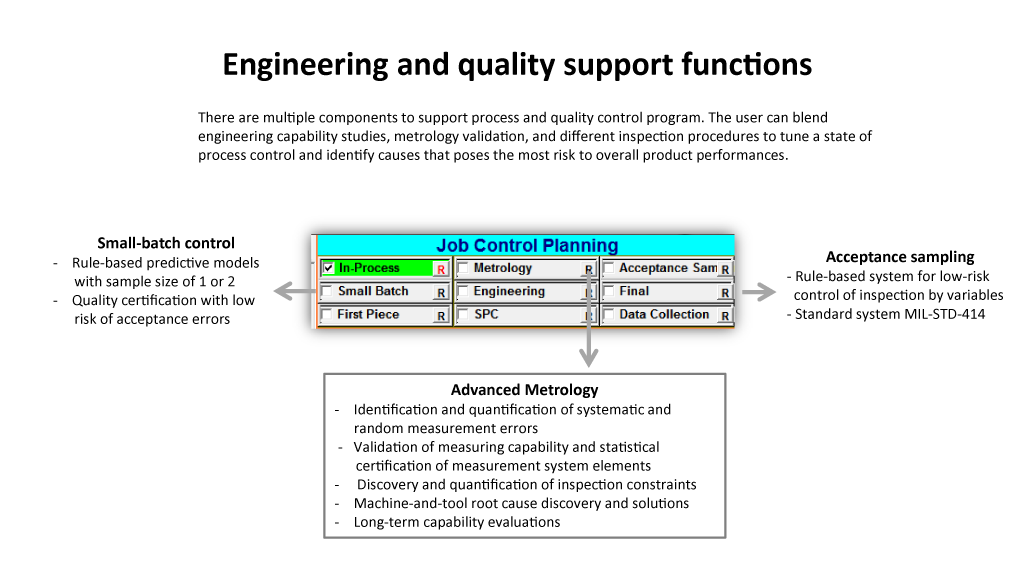Know-how for planning with connected MICRONITE methodologies
Build the best control plan for machining operation to match any type of equipment and product
The general Control Plan requirement gives you the ability to separate plant-wide common domain and job-specific domains. The common domain includes a metrology knowledge base and historical database on machine capability to produce close-tolerance components. The main requirements of intelligent planning and optimization are to be able to build a “total” job control model which includes operational and tooling information, a set of process control models, series of procedures providing engineering support, and quality acceptance sampling.
The Issue
- APQP and Control Plan is the general methodology which does not cover major components constituting control of machining and grinding. Control plan must fit requirements of specific operations what defies one-size-fit-all APQP philosophy. Control plan descriptors should be custom-tailored due to a variety of business conditions.
- APQP programs are designed exclusively for high-volume and continuous production leaving behind 20,000 machine shops and majority of large manufacturing companies producing components in small- and middle-range volumes
- Common miscalculations in control plan design are commonly accepted by a customer who has no knowledge of process insights
- Control plan is disconnected from the actual inspection process which requires adaptiveness of sampling interval to tool wear and process instability
- There is no procedure offered to validate a control plan in terms of sample size and sampling interval
- There is no reference to an adequate model which will be used for process control
- There is no mechanism to optimize a control plan or reduce amount of inspection using the feedback from in-process data
- Control plan design takes many hours of non-productive engineering time
The MICRONITE Solution
- Transformation of general APQP methodology into intelligent operation-specific planning of effective process and quality control
- Creation of operation folder with necessary descriptors, drawing, and detailed control plan
- Automatic download of CAD drawing and classification of characteristics by tolerance range or functionality
- Assignment of gages, CMM, or Vision System to dimensional characteristics with work instructions
- Major components of MICRONITE plan for control of machining and grinding are: (1) predictive or fixed control models for small-batch and high volume production, (2) quality-protective inspection schemes, and (3) various inspection types assigned to an operation including First Article Inspection,, measurement metrology, capability study, and final inspection
- Constant review and optimization of control plan – armed with the right data
- Connection of planned sampling scheme with quality certification providing acceptance of total sample size or forcing final inspection
- Coordination of in-process and offline inspection for small-batch production
- Design of multiple data capture schemes for control of watch-feature capability
The Benefits
- 90% reduction of labor and time. Spend less time and effort using automated plan designs that work in both batch and high-volume environments
- Simplified planning and control of the entire data integration process
- Better decisions and faster actions based on underlying analytics capabilities
- Reduction of inspection time for stable processes
- Taking the guesswork out of planning using proven procedures that’s both easy-to-use and powerful
Intelligent planning – major new developments are changing the way a control plan works
• Machining-specific predictive models for real-time control of both small-batch and high-volume machining
• Design of inspection schemes for metrological analysis and validation of all elements of measurement system
• Design of inspection schemes for analysis of multiple causes contributing into cumulative process capability
• Inclusion of acceptance systems for inspection by variables into an operational control plan
• Design of inspection procedures based on critically of quality characteristics and known capability of cutting tools
• Elimination of process control inefficiencies by system-signaled detection of errors and plan re-design
• Modification and improvement of control plan during a production run
FlexPlan, MICRONITE’s cutting-edge control plan design offers a much higher level of application versatility and integration strategy compared to simpler and more often irrelevant to machining APQP and SPC. MICRONITE’s experienced users often cite choice of predictive models as the most powerful and essential aspect of MICRONITE’s capability to handle the most complex process challenges, year after year. MICRONITE users can assign unlimited number of operations per job with nine inspection types per each operation, and select a control model or sampling scheme for each inspection type. MICRONITE’s plan flexibility and options ensure its effectiveness for downstream process control. MICRONITE’s FlexPlan is designed to rationalize a multitude of functions required for the control of small-batch and high-volume production, control of close and extremely close tolerances, manufacturing cells, etc. With a broad range of analytical techniques – predictive models, metrological gaging analysis, acceptance sampling systems, multi-variable capability studies, etc. MICRONITE gives its users a tremendous advantage in planning of process control and uncovering hidden problems and relationships.
MICRONITE has a well-designed control plan that significantly increases the effectiveness of our process analysis while focusing the alert generation on details that pose as the most quality risk. This process involves automatic reduction of sampling interval and early warning with stop decision. The user can respond effectively to emerging problems by optimizing the plan during the production run. MICRONITE’s a huge advantage compared to APQP. MICRONITE’s system exposes weaknesses of initial planning and errors in any process of engineering. A further, plan and corrective actions could be easily adapted to the operation reality with MICRONITE.
With MICRONITE there are multiple components to support our process and quality control program. The MICRONITE user can blend engineering capability studies, metrology validation, and different inspection procedures to tune a state of the process control and identify causes that poses the most risk to overall product performances.
Unlike existent practices with establishment of the fixed control plan approved by a customer, MICRONITE users are advised to modify a control plan according to the results of the process data analysis. To find the optimal plan solution, a heuristic tool-and-quality chart is generated by the system with automatic search for “TOP Focus” tools and characteristics. It is very important that a control plan can be adapted to operation specific requirements. The user can always add “root cause” studies and change the type of model, inspection interval, sample size, etc. An optimal control plan becomes a centerpiece of continuous improvement.




